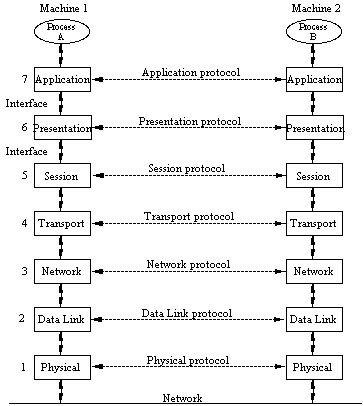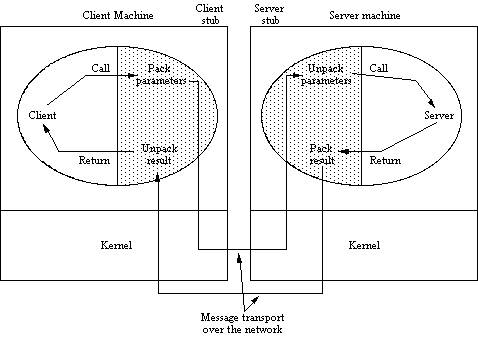INTRODUCTION
TO
OPERATING SYSTEMS
Lecture 18: COMMUNICATION IN DISTRIBUTED OPERATING SYSTEMS
CHRIS STAFF
Dept. of Computer Science and Artificial Intelligence
University of Malta
Lecture Outline
Aims and Objectives
Issues
OSI in a nutshell
Asynchronous Transfer Mode (ATM) Networks in a nutshell
The Client-Server Model in a nutshell
Remote Procedure Call in a nutshell
Group Communication
Aims and Objectives
Issues
- Processes which execute on CPUs sharing memory can easily communicate, but
what about processes executing on CPUs which don't share memory?
- How to implement message passing (communication)
- Speed of communication
- Reliability of communication
- Transparency of communication
- Locating the right process to communicate with
- Consistency of Communication
OSI in a nutshell
- Defines a standard for open systems to communicate
- 2 Generic Types
Connection-oriented
Connectionless
- OSI generally gives users/applications the impression that
connection-oriented communication is provided
- What happens in lower layers in the model is hidden from users/applications

7. The Application Layer
- High-level application protocols, e.g., e-mail, video conferencing, file
transfer, etc.
6. The Presentation Layer
- Concerned with the meaning of bits in the message
- Notifies receiver that message contains a particular record in a certAin
format
5. The Session Layer
- Provides dialog control and synchonisation facilities
- Checkpointing can be used so that after recovering from a crash transmission
can resume from the point just before the crash
- Rarely used
4. The Transport Layer
- Provides a mechanism to assure the Session Layer that messages sent are all
received without any data corruption or loss
- Breaks message from Session Layer into appropriate chunks (e.g., IP Packets),
numbers them and sends them all
- Communicates with receiver to ensure that all have been received, how many
more the receiver can receive, etc.
3. The Network Layer
- Determines route (next hop) message will take to bring it closer to its
destination
2. The Data Link Layer
- Detects and corrects data transmission errors (data corruption, missing data,
etc.)
- Gathers bits into frames and ensures that each frame is received correctly
- Sender puts special bit pattern at the start and end of each frame + a
checksum + a frame number
1. The Physical Layer
- Concerned with Transmitting Bits
- Standardizes the electrical, mechanical and signalling interfaces
Asynchronous Transfer Mode (ATM) Networks in a
nutshell
- Advances in network technology introduce high-speed networks capable of
transfering multimedia data at rates of 155 Mbps and up, using either
point-to-point and/or broadcast communications
- Can now implement high-bandwidth distributed systems
- ATM grew out of a need for a single network capable of carrying data in low
constant data rates (e.g., voice) and bursty data traffic
- ATM carries fixed-sized blocks (cells) over virtual (connection-oriented)
circuits
- When two or more computers need to communicate, the sender first establishes
a connection. The network helps to determine the route and then future
conversations are carried over the same route, until the connection is
dropped
- The routing information is stored in switches. When the connection is
dropped, the routing information in the switches is purged
The Client-Server Model in a nutshell
- The OS is structured as a group of cooperating processes (servers) that offer
services to users (Clients)
- Clients and Servers run the same microkernel
- Connectionless request/reply protocol used
- Client requests a service from a server using send(dest, &mptr).
Server waits for a message to be recieved using receive(addr,
&mptr), performs the task and sends the data or error code
- No overheads of setting up/dropping a connection, passing messages through
multiple layers, etc.
- A name server is used for clients to determine the machine running the
process with which they want to communicate
Remote Procedure Call in a nutshell
- Programs on one computer are allowed to call procedures located on other
computers
- Identical to one program calling another on the same machine (with
parameters, return results, etc.)
- Problems...
- Processes don't share memory
- Locating the machine running the procedure
- Machines involved can use different microkernels
- Reference parameters
- One of the machines might crash
Example

- On machine 1, program rand is replaced by a client stub
- Machine 2 has both a server stub for rand as well as the
rand procedure
- Machine 1 doesn't realise that rand is located on a different machine
- rand on machine 2 doesn't realise that it has been called by a procedure on a
remote machine
- The client stub packs the parameters (including the procedure name) into a
message (parameter marshalling) and passes the message to machine 2. The client
then waits to receive the result
- The server stub for rand will have been waiting to receive a message. When
one arrives, it unpacks the parameters and calls the rand procedure. The
procedure returns the result to the server stub which sends the new message
back to the client. When the client stub for rand receives the message, it
unblocks, unpacks the message and passes the result to the calling procedure
Parameter Passing in RPC
- What if seed had been passed by reference instead of by value?
- Option 1: Forbid Call-by-Reference
- Option 2: Simplest way is client stub to allow calling procedure to use
reference parameters, but during parameter marshalling to replace the reference
with the actual value
ok for small amouts of data, client stub will place the results in the
appropriate memory locations on receiving them. Call-by-Copy/Restore
bad for pointers to complex data types
- Optimise above depending on whether remote procedure will read from or write
to the address
- Option 3: Flexible, but inefficient method is to simply send server stub the
address in the message. Server stub will realise it's a pointer and will send a
request to the client for the data at that memory location, etc...
Clients-Servers use different microkernels
- Can be a major problem as different architectures can expect data to be
encoded differently (character codes, representations, etc.)
- Simplest thing to do is allow each client to use its native format, and
identify the format in the first byte of the message.
- Receiving server converts the data to its own format if it needs to
Dynamic Binding
- One or more computers act as a binder
- When RPC servers are started up they register with the binder
- When a client wants to perform an RPC it asks the binder for the server's
address
- Using one machine as the binder means that if it crashes, clients can find
servers
- If multiple machines are used as binders, there is overhead keeping them
consistent
Dealing with Failures
- Several types of failure
Client unable to locate server
Request message from client to server is lost
Reply message from server to client is lost
Server crashes after receiving request
Client crashes after sending request
Group Communication
- The models discussed previously mainly dealt with
point-to-point communications
- What if communication involves multiple processes that need to synchronise
their execution?
- For example, a fault-tolerant file service incorporating multiple file
servers
- All members of the group need to receive the message in one operation, and
possibly in the correct sequence
- Groups are dynamic
- How can members of a group all receive the same message?
Group organisation and Group Management: Peer-to-Peer or Hierarchical
- How can messages be guaranteed to be received correctly and in the right
order?
Atomic Broadcast: All machines received message or none of them do.
All-or-nothing
Consistent Time ordering: pick one of several messages received "at the same
time" and deliver it first
Next Lecture...
Synchronisation in Distributed Operating
Systems


